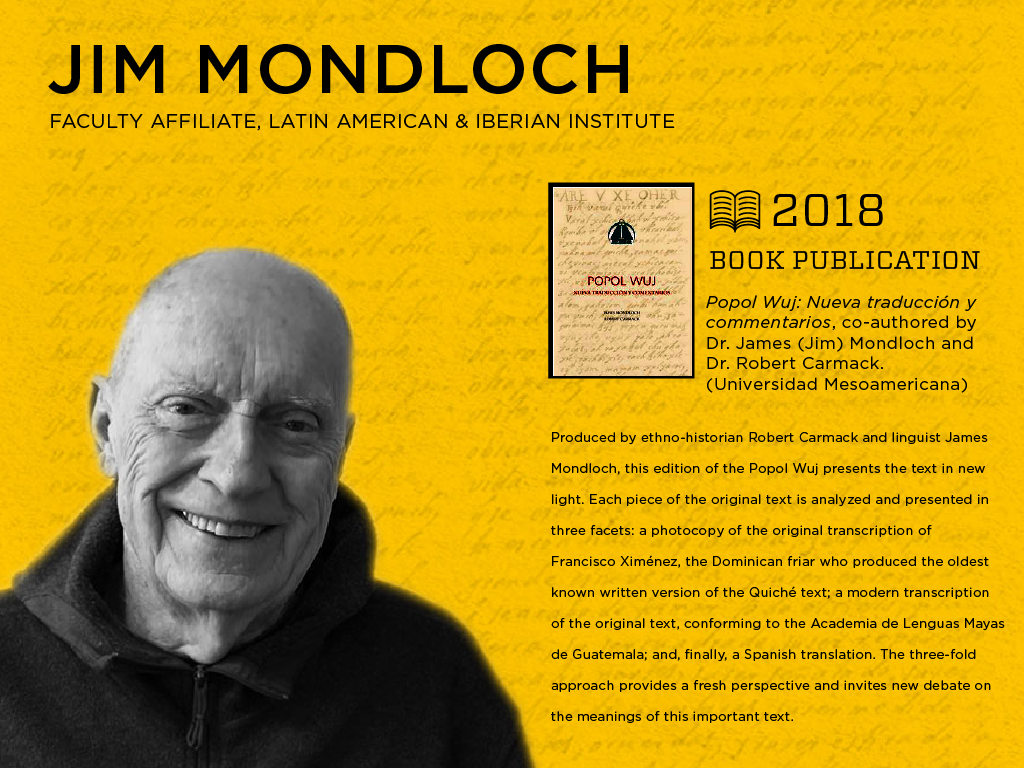Professor James Mondloch Presents New Transcription and Translation of Popol Wuj
December 10, 2018

A new transcription and translation of the Popol Wuj, the sacred book of the K'iche' Maya people, has been published. This monumental effort was achieved by none other than Dr. James (Jim) Mondloch, a linguistic anthropologist and faculty affiliate of the UNM Latin American and Iberian Institute, and his colleague, ethnohistorian Robert (Bob) Carmack, Professor Emeritus at the State University of New York at Albany. It was edited by noted Nicaraguan historian Horacio Cabezas Carcache.
The book was released in October, 2018, by the Universidad Mesoamerica in Guatemala. Shortly afterward, Mondloch traveled to Guatemala to celebrate its launch. Formal public presentations were held in Guatemala City and Quetzaltenango on October 4 and 5, 2018, with Mondloch presiding as the sole keynote speaker given that Carmack was unable to attend for health reasons. Photos from the presentations can be seen on the website of the Universidad Mesoamerica. You can also watch a recording of the presentation on YouTube.
As Mondloch shared in an interview with the Guatemalan news source La Hora, "El Popol Wuj es impresionante. Nunca he visto un libro tan precioso. Por los comentarios que he recibido en las presentaciones del libro me parece que las personas están fascinadas con este texto del Popol Wuj, es un libro magnífico, no existe otro en América de esta calidad que presenta la cultura precolombina, es un tesoro para la lengua, todas las formas gramaticales del k’iche’ se encuentran allí."
To undertake a new translation, transcription, and annotation of such a historical document is a monumental task, one which, Mondloch recounts, began nearly 20 years ago. When asked about the impetus behind it, he recalls that he was first inspired by a workshop he conducted in 1987 that focused on sixteenth-century K'ichee' and Kakchikel Mayan documents. At that time, while working with a group of Mayan para linguists, he discovered a common frustration: their shared inability to understand many of the obscure passages of the Popol Wuj. It was shortly thereafter that he decided to undertake his own transcription, translation, and annotation of what he calls "that wonderful manuscript."
By 1990, Mondloch's friend and colleague, Carmack, became involved in the project. Their collaboration drew upon earlier co-authored publications, including the transcription, translation, and annotation of several other sixteenth-century Mayan manuscripts: el Título de Totonicapan (1983), el Título de Yax (1989), and el Título Koyoi (2009). They divided the labor, with Carmack agreeing to contribute an analysis of the Popol Wu as well as commentary on previous English translations. Mondloch assumed responsibility for producing an updated transcription of the K'ichee' text which would employ the current alphabet in use for writing Mayan languages, contribute notes with linguistic observations of the text, and translate the text into Spanish.
In 2013, the Universidad Mesoamericana de Guatemala invited Mondloch and Carmack to produce a Spanish translation and annotation of the Popol Wuj for publication by the same university. As the project evolved, two additional contributors became a part of the process, offering invaluable assistance. Mondloch's wife, Maria, a native speaker of K'ichee', assisted with deciphering some of the more obscure passages in the text. Carmack's wife, Teresa Caranza de Carmarck, a native of Peru who holds a PhD in Hispanic Linguistics and Hispanoamerican literature, assisted in reviewing and refining the Spanish translations.
Those interested in learning more about this publication may see an open access copy of the book, at least for the time being, shared courtesy of the Universidad Mesoamerica: Popol Wuj - Nueva Traducción y Comentarios.
Mondloch's interest in Guatemala began when he moved there in 1965 as a Catholic missionary. He spent the best part of the next fifteen years living and working in the coastal K’ichee’ speaking communities of Nahualá and Santa Catarina Ixtahuacan in the Departamento de Sololá. During those years, he immersed himself in the study of the K’ichee’ language and culture. He has written and published a number of books and articles on those subjects, including the only K’ichee’ grammar book found in English, Basic K’ichee’ Grammar. He later earned his PhD in Linguistics and Anthropology from the State University of New York at Albany in 1981. In 1976, he married Maria Tahay Carrillo, a native of Santa Catarina Ixtahuacan, Guatemala. They were forced to leave Guatemala in 1981 due to the terrible violence inflicted on the Mayan Communities by the Guatemalan government military and police at that time. Since their arrival in the U.S., New Mexico has been home. Mondloch has long taught courses in the K’ichee’ Maya language at UNM, beginning in 1991. His classes have a strong following of dedicated students. Recently, he also oversaw the K'iche' Maya Oral History Project, which involved the digitization of over one hundred oral histories he recorded during his earlier years in Guatemala.
